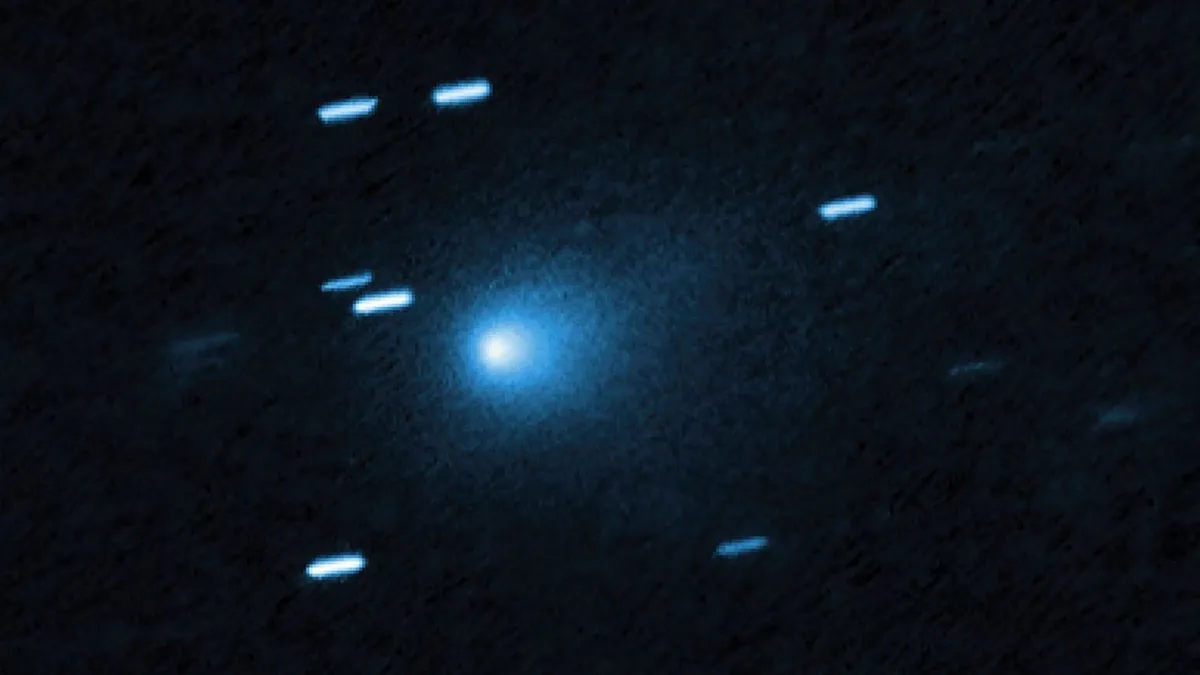
The interstellar comet 3I/ATLAS is set to reach its perihelion, the closest point to the sun, on October 30. This significant event will mark a peak in the comet's activity as it makes its closest approach, approximately 1.35 astronomical units (AU) from the sun, equating to about 125 million miles (202 million kilometers). While 3I/ATLAS is currently obscured from view as it travels behind the sun, various spacecraft positioned throughout the solar system continue to monitor its progress.
Perihelion is a critical phase in a comet's orbit, where it comes closest to the sun. Unlike planets, which follow near-circular orbits, comets like 3I/ATLAS exhibit highly eccentric paths. As they near the sun, the increasing temperatures cause ices on their surfaces to sublimate, resulting in outgassing. This process generates a cloud of gas and dust known as a coma that envelops the comet's nucleus. Furthermore, comets often develop two distinct tails: a dust tail and an ion tail, which consists of charged particles stripped away by the solar wind. This outgassing significantly increases the comet's brightness, making it more visible, especially around perihelion when activity is at its peak.
As an interstellar object, 3I/ATLAS does not orbit the sun in the same manner as traditional comets; instead, it is merely passing through our solar system. Its trajectory allows it to approach the sun and then move away again, thus experiencing its own perihelion. Unfortunately, 3I/ATLAS entered solar conjunction at the end of September, becoming concealed by the sun's glare while it rounded the far side. For observers on Earth, this means that the comet will not re-emerge in the morning sky until late November or early December, making it impossible for terrestrial telescopes, including those positioned at the L2 Lagrange point, to observe its perihelion.
While Earth-based observations are compromised, a fleet of spacecraft exploring our solar system will have better vantage points to observe 3I/ATLAS as it approaches perihelion. Notably, missions stationed at Mars have a direct view of the hemisphere of the sun that 3I/ATLAS is currently navigating. This includes the Mars missions that witnessed the comet's closest approach to the Red Planet on October 3, when it was just 0.19 AU (17.6 million miles or 28.4 million kilometers) away.
Other missions, such as NASA's Psyche mission to the asteroid of the same name and the Lucy mission targeting Jupiter's Trojan asteroids, will also monitor 3I/ATLAS during its perihelion. Additionally, the European Space Agency's JUICE probe, on its way to the Jovian system after a recent flyby of Venus, will be well-positioned to observe the comet. However, it's important to note that JUICE is currently using its main antenna as a sun shield, delaying its ability to transmit data back to Earth until February.
Scientists are particularly keen on studying the chemistry of 3I/ATLAS during perihelion. The gases and dust expelled from the comet offer valuable insights into its composition. Initial findings indicate that 3I/ATLAS contains more carbon dioxide and a higher abundance of nickel compared to typical solar system comets. These characteristics provide clues about the molecular cloud from which the comet originated over seven billion years ago and allow astronomers to compare the chemistry of our solar system with that of the comet's home star system.
As perihelion approaches, researchers anticipate that additional molecular emissions may be detected. While previous observations have shown a lack of iron emissions, scientists are eager to determine whether iron activity will increase as 3I/ATLAS reaches its closest point to the sun.
In summary, the impending perihelion of 3I/ATLAS presents an exciting opportunity for scientists to gain insights into the chemistry of this interstellar comet, despite the challenges of Earth-based observations. With multiple spacecraft poised to observe the comet's behavior, valuable data will soon emerge, furthering our understanding of these fascinating celestial wanderers.